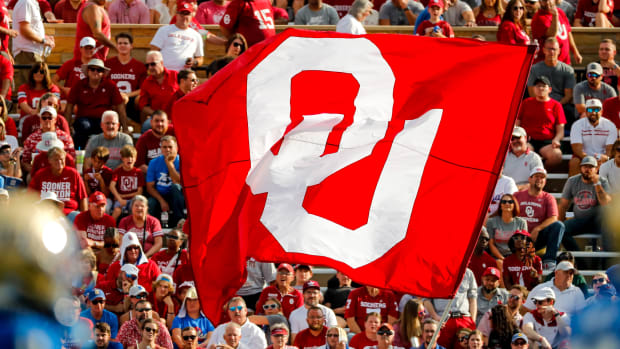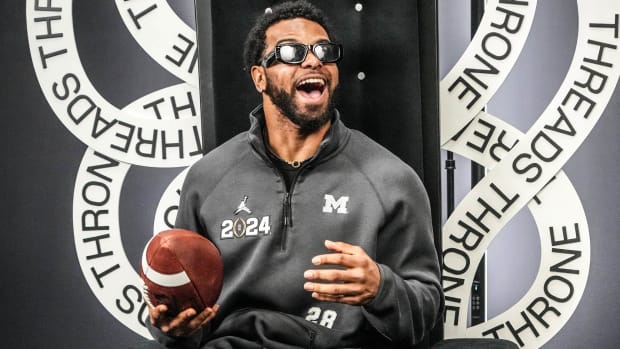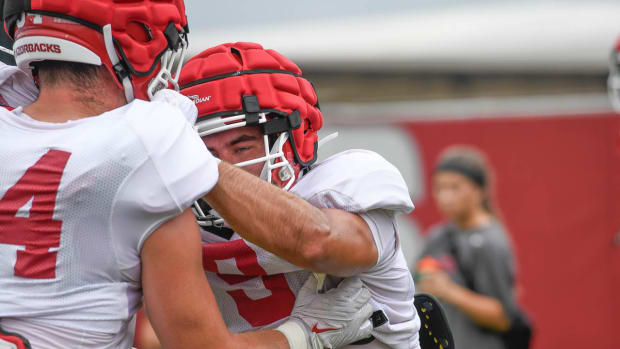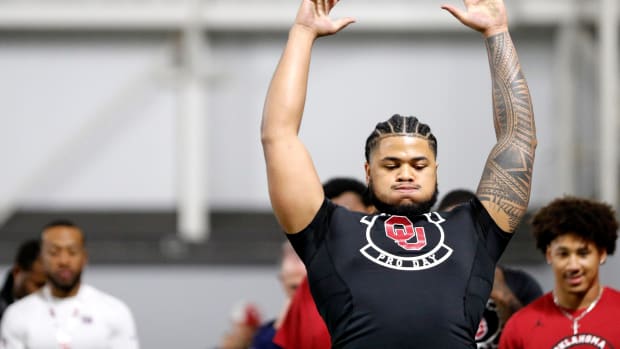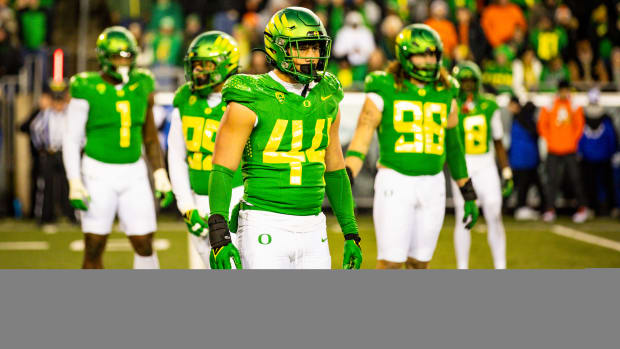'I get on their asses if they give up a yard': The secret to West Virginia's defensive success in high-scoring Big 12
The prevailing wisdom among Big 12 defensive coordinators—non-Kansas State division—is that yards and points inevitably will be surrendered in a 10-team league that features nine predominately up-tempo offenses. Unlike his counterparts, West Virginia defensive coordinator Tony Gibson refuses to concede anything. "I get on their asses if they give up a yard," Gibson told Campus Rush this week.
Demanding a low score in the Big 12 is easy to say and considerably more difficult to do, particularly for a defense that had to replace eight starters from 2015. (That number jumped to nine when safety Dravon Askew-Henry, the Mountaineers' most experienced defender, was lost for the season to a knee injury in preseason camp.) Despite this, No. 10 West Virginia (6–0) has allowed an average of 14.3 points in its first three conference games.
That isn't a result of catching the worst offenses early, either. Remember how Texas Tech rang up 854 yards (7.8 per play) in a 66–59 loss this past Saturday in the most Big 12 game that ever Big Twelved? On that same field a week earlier, the Mountaineers held the Red Raiders to 379 yards (4.9 per play) in a 48–17 West Virginia win. A week later, West Virginia held a TCU offense that came in averaging 6.8 yards a play to five yards a play in a 34–10 win. Saturday, the Mountaineers will try to slow another fast-paced offense when they visit Oklahoma State.
A few weeks ago, the SI college football writers had a conference call to pitch story ideas. One potential story would have focused on why it seemed impossible to run an effective defense opposite an Air Raid offense. Texas Tech was getting shredded. So was Oklahoma. So was TCU. Fortunately, we waited on that one. Because Gibson's defense would have made fools of us. What's amazing about West Virginia's defense isn't that it is stingy for the Big 12. It would be stingy in any league, and in the Big 12 that makes it downright dominant.
Does Gibson have some sort of secret schematic trick that Big 12 quarterbacks and playcallers can't unlock? Nope. He'll tell you what he does. The Mountaineers play a 3-3-5 (three down linemen, three linebackers and five defensive backs). This is a popular alignment against up-tempo teams because the three down linemen allow coordinators to disguise coverages and pressures more easily than a four-man front. This makes quarterbacks think more about where the fourth man is coming from, and anything that makes the quarterback hesitate even a millisecond can disrupt an up-tempo offense that relies on timing and rhythm.
Except Gibson doesn't always bring a fourth man. In the first two series at Texas Tech—both three-and-outs—he rushed three men on five of the six plays. This allowed the Mountaineers to drop eight into coverage. Receivers running deep faced cornerbacks and safeties. Short routes could result in catches, but those receivers got swarmed before reaching the first-down marker.
The problem for opposing offenses is the Mountaineers can look exactly the same before the snap whether they're dropping eight or bringing five rushers. On the third play West Virginia faced against Texas Tech, Gibson dropped six and brought five. This probably disappointed West Virginia players who would have preferred to rush six. "That's the style they like to play," Gibson said. "If I gave the 11 guys on the field the chance to choose what call I make, nine of them would say zero blitz."
A zero blitz means defensive backs are matched one-on-one with receivers with no safeties remaining deep to help down the field. The two who wouldn't ask for the zero blitz are probably defensive linemen—who get to rush the quarterback anyway. Playing this way requires supreme confidence in the cornerbacks and safeties to win their one-on-one matchups and cover until the rushers can reach the quarterback. "I like to be in man coverage all the time," cornerback Rasul Douglas said. "We can get after the quarterback and make him feel uncomfortable. Once he feels uncomfortable, he gets rattled and starts throwing passes he normally wouldn't throw."
Raymond Thompson/AP
Those blitzes also allow the coordinator and the assistants to have some fun designing plays that will free various defenders to reach the quarterback, which is why Gibson's linebackers and defensive backs regularly drop by his office with ideas for new pressures. It's a high risk/high reward proposition, and the Mountaineers have been amply rewarded this season. They only rank 68th in the country at two sacks per game, but their pressure has forced opposing quarterbacks to make throws before they want to make them. That leads to interceptions—West Virginia has seven in six games—incompletions and receivers tackled before they can move the chains.
To understand what this mix does to a quarterback, imagine the quarterback as a batter and the defense as a pitcher. The rush-three, drop-eight plays are like facing an in-his-prime Greg Maddux. The pitches are only in the mid-80s, but they're located so perfectly that a grounder to short is the most likely outcome. The zero blitzes are like facing an in-his-prime Nolan Ryan. The ball might come down the heart of the plate, but it's coming at 98 mph—and that looks even faster after seeing the Maddux stuff. What makes Gibson's defense so tough is that Maddux can turn into Ryan (or vice versa) in the middle of his windup, and the batter doesn't know exactly what he's facing until just before the ball leaves the pitcher's hand.
After losing Askew-Henry in camp, Gibson wasn't sure the Mountaineers could play this way. Yes, Douglas had shaken off a rough first season after transferring from junior college to develop into a future pro. Yes, Jarrod Harper had filled in for Karl Joseph when the future first-rounder was lost for the season to injury last year. But the Mountaineers needed newcomers to contribute. Gibson suspected Lackawanna College transfer Kyzir White—the brother of former West Virginia receiver Kevin and current Mountaineers receiver Ka'Raun—would be able to take over at the safety/linebacker hybrid Spur position, but he didn't realize how versatile the 6'3", 221-pounder would be. Meanwhile, the Mountaineers had no idea what they had in Dodge City (Kan.) Community College transfer Elijah Battle until he came from off the two-deep to earn a starting cornerback spot in the season's first month. "If you'd asked me two months ago if we'd be sitting here playing as well as we are on defense, I'd have said, 'Hell no.'"
Andy Lewis/Icon Sportswire via Getty Images
The less obvious reason the Mountaineers have improved so much on defense is the offense. It isn't just that quarterback Skyler Howard & Co. have improved since last season—they have—it's that head coach Dana Holgorsen has evolved his Air Raid scheme to incorporate more traditional aspects such as huddling, fullbacks and tight ends when necessary.
Meanwhile, instead of dictating the pace of practice the way many of his up-tempo colleagues do, Holgorsen collaborates with Gibson. He finds out what the defense needs to see and gives them the look that will better prepare the Mountaineers to stop an opponent.
Holgorsen and Gibson also have a "shared custody" agreement with quarterback Will Grier, who is sitting out this season after transferring from Florida. Grier gives the defense such a good look as the scout team quarterback that Gibson wants him all the time, but Holgorsen needs him watching the Mountaineers' offense because Grier is expected to succeed Howard in 2017. Holgorsen and Gibson have figured out how to share.
POWER RANKINGS: Where does West Virginia rank entering Week 9?
They also make it work on the field. Saturday, Holgorsen ordered his offense to huddle and bleed the clock for much of the second half. Few Air Raid coaches would do that, but the results were undeniable. In the third quarter against TCU, Gibson's defense faced four plays and was on the field for 1:14. And even though they huddled, the Mountaineers moved the ball. They mounted drives of 15 and 11 plays in the quarter and scored 10 points to stretch their lead to 21. Holgorsen chalked up the schematic shift to common sense. "It's hard to score. It's hard to move the ball," he said. "It's hard to do a lot of things when you don't have the ball."
Still, Gibson knows that playing in the Big 12 means some team will eventually get the ball and pop the Mountaineers for a few big gains. After every practice, he warns his players that when this happens, they'll need to forget it and try to get a three-and-out on the next possession. "I don't want them getting too overconfident about it," Gibson said. "We need to be on guard for when somebody does come out and hits some big plays. How do we respond to that?"
And though it may sound as if Gibson is conceding that an opponent might pile up some points on the Mountaineers, don't worry. He'll still get on their asses if they give up even one.



